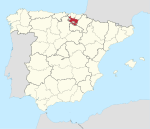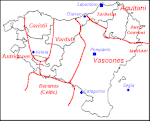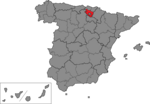Tower of Mendoza
Bien de Interés Cultural landmarks in ÁlavaBuildings and structures in ÁlavaCastles in the Basque Country (autonomous community)Spanish castle stubsTower houses in Spain

The Tower of Mendoza (Spanish: Torre de Mendoza, Basque: Mendoza dorretxea) is a tower located in Vitoria-Gasteiz, Spain. It was declared Bien de Interés Cultural in 1984. The tower is strategically located between the roads of Old Castile and the Ebro river. The Tower of Mendoza is a fortified tower located in the village of Mendoza, near Vitoria-Gasteiz (Álava, País Vasco, Spain). It was built in the thirteenth century as a residence of the House of Mendoza.
Excerpt from the Wikipedia article Tower of Mendoza (License: CC BY-SA 3.0, Authors, Images).Tower of Mendoza
Vitoria-Gasteiz
Geographical coordinates (GPS) Address Nearby Places Show on map
Geographical coordinates (GPS)
| Latitude | Longitude |
|---|---|
| N 42.859722 ° | E -2.773611 ° |
Address
5
01191 Vitoria-Gasteiz (Mendoza)
Autonomous Community of the Basque Country, Spain
Open on Google Maps






